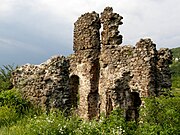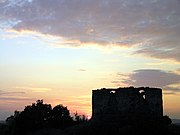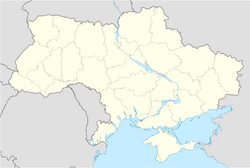| Main | Births etc |
|---|
| Vynohradiv Ukrainian: Виноградів| Hungarian: Nagyszőlős Slovak: Vinohradov, Veľká Sevljuš Romanian: Seleuşu Mare Russian: Виноградов German: Wynohradiw |
|||
|---|---|---|---|
| — City of district significance — | |||
| Central Vynohradiv looking towards Black Mountain | |||
|
|||
| Location of Vynohradiv Rayon in Zakarpattia Oblast | |||
| Coordinates: | |||
| Country | |||
| Oblast | |||
| Raion | Vynohradiv Rayon | ||
| Founded | 1262 as Sevliush | ||
| Incorporated | 1946 | ||
| Government | |||
| • Mayor | István Bocskai | ||
| Area | |||
| • Total | 32.09 km2 (12.39 sq mi) | ||
| Elevation | 134 m (440 ft) | ||
| Population (1 Oct 2015) | |||
| • Total | 120 940 | ||
| • Density | 1,272/km2 (3,290/sq mi) | ||
| Time zone | EET (UTC+2) | ||
| • Summer (DST) | EEST (UTC+3) | ||
| Postal code | 90300-90305 | ||
| Area code | +380-3143 | ||
| Website | http://www.rada.vynogradiv.com.ua/ | ||
Vynohradiv (Ukrainian: Виноградів|, Hungarian: Nagyszőlős) is a city in western Ukraine, Zakarpattia Oblast. It is the center of Vynohradiv Rayon. Population: 120 940
Names[]
There are multiple alternative names used for this city due to its location and history: Hungarian: Nagyszőlős, Romanian: Seleuşu Mare, Rusyn: Cивлюш (Syvlyush), Russian: Виноградов (Vinogradov), Yiddish: סעליש (Seylesh, Selish), Slovak: Vinohradov (Veľká Sevljuš during Czechoslovak rule), German: Wynohradiw.
Location[]
The city lies near the river Tisza on the border with Romania. It is 35 kilometres (22 mi) from Berehove.
History[]
It was first mentioned in 1262 by the name Zceuleus. Its Hungarian name, Nagyszőlős ("Big Grape"), stems from the area being an important wine district. The city was called Sevlush (the Rusyn transliteration of the Hungarian word szőlős, grape).
The town was one of the oldest in Ugocsa county, and was inhabited by winemakers of the royal court. In 1329, Hungarian King Charles Robert granted privileges to the town, which became the seat of the Comitatus (the city held this rank until the Treaty of Trianon was signed in 1920).
In 1717, most of the citizens of the town were killed by an invading Tatar horde. By 1880, the population was about 4,400 (with 500 native Romanians). In 1881 a secondary school was opened.
In 1910 it had a population of 7,811 (5,943 or 76% Hungarians, 1,266 or 16% Ruthenians (Rusyns) and 540 or 7% Germans). The religious make-up was 3,311 Greek Catholics (42.5%), 2,237 Jews (28.6%) and 1,124 Calvinists (14.4%).
This city had a Jewish ghetto in 1944. At its height from May to June 1944, most of the Jews of this section of Zakarpattia were deported to the Auschwitz concentration camp to be gassed shortly after arrival. Jews from the area typically spent about two weeks in the ghetto before being deported. Conditions were extremely cramped with many families housed in a single room, a deliberate arrangement meant to cause suffering and disease.
In 1944, Carpathian Ruthenia became part of the Soviet Union. The city name became Vinogradovo (Russian), Vynohradiv (Ukrainian), or Vynohradovo (Ruthenian). All mean "Grape City."
Today 13% of the population is Hungarian (census of 2001).
Demographics[]
According to the 2001 census, the population included:[1]
- Ukrainians (82.13%)
- Hungarians (13.54%)
- Russians (3.82%)
- Gypsies (0.6%)
Tourist sights[]

Street map of Vynohradiv and surrounding area (Ukrainian).

Ugocsa Castle
- Ugocsa Castle (ruins; 13th century). It was first mentioned in 1308. In 1315 King Charles Robert attacked and destroyed it. In the 15th century the area was given to monks of the Franciscan order, they built a monastery there, which was inhabited until 1558. There is a small 14th century chapel south of the ruins.
- Perényi Castle. It was built by the Perényi noble family from 1399, later rebuilt in baroque style into a mansion.
- Franciscan church and monastery (built in 1744, rebuilt in 1889).
- Our Lady's Church (13th century, rebuilt in the 15th century in Gothic style, restored in the early 20th century. Its furniture was destroyed after 1945. The Church got it back in 1989.
- Franciscan monastery (founded in the 15th century). In 1556 local Protestants attacked the monastery, killed the monks and threw the body of St. John Capistrano into a well. The Perényi family invited monks of the order to the town again, but the monastery burnt down in 1747. Its current building was erected in 1889.

The ruins of a castle in Vynohradiv.
- Protestant church (Neoclassical, 1828).
- Old county hall (now the building of the Zsigmond Perényi Secondary School) and statue of Perényi (1906).
Famous people[]
- Composer Béla Bartók lived in the house opposing the mansion between 1889 and 1892; his mother worked here as a teacher. Bartók held his first concert here in the county hall.
- József Csorba, doctor, physicist was born here in 1789.
- János Majos, Kuruc captain was born here.
- Imre Révész, painter was born here in 1859. He is buried in the local cemetery.
- Endre Nagy, writer, stage director was born here in 1877.
- Gábor Döbrentei, philologist and antiquarian was born here in 1786
- Edvin Marton, world-famous Ukrainian composer and violinist of Hungarian ethnicity
- Mykhaylo Koman, footballer and coach of Dynamo Kyiv, grew up here
International relations[]
Twin towns — Sister cities[]
Vynohradiv is twinned with:
Nyírbátor in Hungary
Fehérgyarmat in Hungary
Dynów in Poland
Vranov nad Topľou in Slovakia
Celadas in Spain
References[]
External links[]
Template:Vynohradiv Rayon
| ||||||||||||||||





